
Buckingham Palace is a London royal residence and the administrative headquarters of the monarch of the United Kingdom. Located in the City of Westminster, the palace is often at the centre of state occasions and royal hospitality. It has been a focal point for the British people at times of national rejoicing and mourning.

Osborne House is a former royal residence in East Cowes, Isle of Wight, United Kingdom. The house was built between 1845 and 1851 for Queen Victoria and Prince Albert as a summer home and rural retreat. Albert designed the house himself, in the style of an Italian Renaissance palazzo. The builder was Thomas Cubitt, the London architect and builder whose company built the main facade of Buckingham Palace for the royal couple in 1847. An earlier smaller house on the site was demolished to make way for a new and far larger house, though the original entrance portico survives as the main gateway to the walled garden.

Wilton House is an English country house at Wilton near Salisbury in Wiltshire, which has been the country seat of the Earls of Pembroke for over 400 years. It was built on the site of the medieval Wilton Abbey. Following the dissolution of the monasteries, Henry VIII presented Wilton Abbey and its attached estates to William Herbert, 1st Earl of Pembroke.

Frogmore is an estate within the Home Park, adjoining Windsor Castle, in Berkshire, England. It comprises 33 acres (130,000 m2), of primarily private gardens managed by the Crown Estate. It is the location of Frogmore House, a royal retreat, and Frogmore Cottage. The name derives from the preponderance of frogs which have always lived in this low-lying and marshy area near the River Thames. This area is part of the local flood plain.

Sandringham House is a country house in the parish of Sandringham, Norfolk, England. It is one of the royal residences of Charles III, whose grandfather, George VI, and great-grandfather, George V, both died there. The house stands in a 20,000-acre (8,100 ha) estate in the Norfolk Coast Area of Outstanding Natural Beauty. The house is listed as Grade II* and the landscaped gardens, park and woodlands are on the National Register of Historic Parks and Gardens.
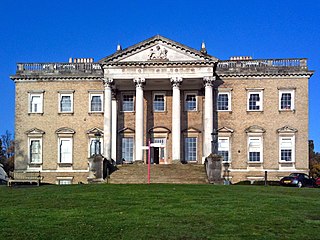
Claremont, also known historically as 'Clermont', is an 18th-century Palladian mansion less than a mile south of the centre of Esher in Surrey, England. The buildings are now occupied by Claremont Fan Court School, and its landscaped gardens are owned and managed by the National Trust. Claremont House is a Grade I listed building.
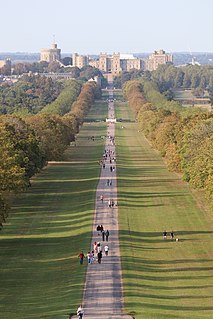
Windsor Great Park is a Royal Park of 2,020 hectares, including a deer park, to the south of the town of Windsor on the border of Berkshire and Surrey in England. It is adjacent to the private 265 hectares Home Park, which is nearer the castle. The park was, for many centuries, the private hunting ground of Windsor Castle and dates primarily from the mid-13th century. Historically the park covered an area many times the current size known as Windsor Forest, Windsor Royal Park or its current name. The only royal park not managed by The Royal Parks, the park is managed and funded by the Crown Estate. Most parts of the park are open to the public, free of charge, from dawn to dusk, although there is a charge to enter Savill Garden.

Bagshot Park is a royal residence located near Bagshot, a village 11 miles (18 km) south of Windsor. It is on Bagshot Heath, a 50-square-mile (130 km2) tract of formerly open land in Surrey and Berkshire. Bagshot Park occupies 51 acres (21 ha) within the designated area of Windsor Great Park.

The Royal Lodge is a Grade II listed house in Windsor Great Park in Berkshire, England, half a mile north of Cumberland Lodge and 3.2 miles (5.1 km) south of Windsor Castle. Part of the Crown Estate, it was the Windsor residence of Queen Elizabeth The Queen Mother from 1952 until she died there in 2002, aged 101. Since 2004, it has been the official country residence of Prince Andrew, Duke of York and his family.

Fort Belvedere is a Grade II* listed country house on Shrubs Hill in Windsor Great Park, in Surrey, England. The fort was predominantly constructed by Jeffry Wyatville in a Gothic Revival style in the 1820s.
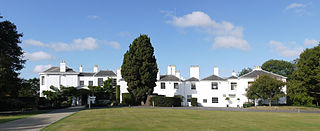
Pembroke Lodge is an initial, mainstream category listed Georgian two-storey large house in Richmond Park in the London Borough of Richmond upon Thames. It sits on high ground with views across the Thames valley to Windsor, the Chilterns and hills in the Borough of Runnymede. It has 11 acres (4.5 ha) of landscaped grounds, including part of King Henry's Mound from which there is a protected view of St Paul's Cathedral in the City of London. The grounds also include memorials to the 18th-century poet James Thomson and the 20th-century rock-and-roll singer and lyricist Ian Dury.
Glenn Paul Howells is a British architect and a director and founder of Glenn Howells Architects.
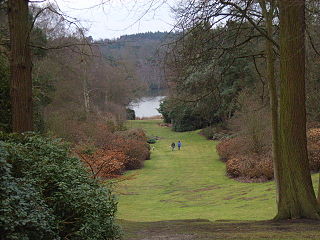
The Valley Gardens are 220 acres (0.89 km2) of woodland garden, part of the Crown Estate located near Englefield Green in the English county of Surrey, on the eastern edge of Windsor Great Park. The Valley Gardens and the nearby Savill Gardens are Grade I listed on the Register of Historic Parks and Gardens.

The Home Park, previously known as the Little Park, is a private 655-acre (265 ha) Royal park, administered by the Crown Estate. It lies on the eastern side of Windsor Castle in the town and former civil parish of Windsor in the English county of Berkshire. To its south is Windsor Great Park.

Windsor Forest and Great Park is a 1,778.9-hectare (4,396-acre) biological Site of Special Scientific Interest in Berkshire and Surrey, located south of Windsor. It is a Special Area of Conservation and Windsor Forest is a Nature Conservation Review site, Grade I. Landscaped woodland gardens are Grade I listed on the Register of Historic Parks and Gardens of Special Historic Interest. Windsor Great Park is a Royal Park of 2,020 hectares, including a deer park,
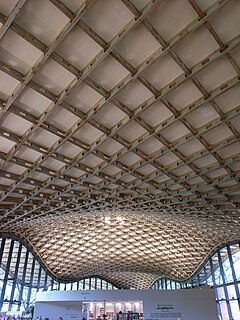
The Savill Building is a visitor centre at the entrance to The Savill Garden in Windsor Great Park, Surrey, England designed by Glen Howells Architects, Buro Happold and Engineers Haskins Robinson Waters. It was opened by the Duke of Edinburgh on 26 June 2006.
Alfred Savill (1829–1905) was the founder of Savills, one of the United Kingdom's largest estate agents.

Castle Ashby House is a country house at Castle Ashby, Northamptonshire, England. It is one of the seats of the Marquess of Northampton. The house, church, formal gardens and landscaped park are Grade I listed.
Andrew Wilson is a British landscape architect garden designer, lecturer and writer. He is a partner in Wilson McWilliam Studio and founded The London College of Garden Design. He has judged for the Royal Horticultural Society at the Chelsea Flower Show, Hampton court and Tatton Park and has also judged the Bloom Festival in Ireland. He wrote a regular column for Gardens Illustrated and contributes to the Royal Horticultural Society's journal The Garden alongside the production of a series of books, the most recent of which are Influential Gardeners, The Book of Garden Plans and the Book of Plans for Small Gardens, The Gardens of Luciano Guibbilei and Contemporary Colour in the Garden. He is also the founding editor of The Garden Design Journal and is a former Chairman and currently a Fellow of the Society of Garden Designers, the UK’s professional body for garden design.

The Royal Chapel of All Saints or Queen Victoria's Chapel is a Grade II listed church in the grounds of the Royal Lodge in Windsor Great Park, Berkshire, England and is a Royal Peculiar, serving as an informal parish church for the inhabitants and staff of the Windsor Great Park. Services at the chapel are often attended by members of the British royal family, and Queen Elizabeth II regularly worshipped at the church for reasons of privacy. The chaplaincy of the Royal Chapel All Saints is held by one of the Canons of the College of St George at St George's Chapel, Windsor Castle.




















